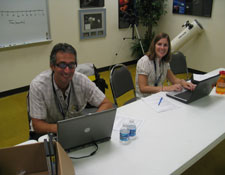
Many educated adults struggle to comprehend such basic relationships as that between Earth's seasonal changes and the tilt of the planet on its axis, or between the role of atmospheric carbon dioxide in developing tree mass and the effects of its odorless release when trees are burned.
Despite recent films, television programs, and publications about human impacts on the climate system, many people still inaccurately associate the problem of global warming with the hole in the ozone layer. (NOAA, 2007). The urgency of the changing climate demands a greater understanding of our climate system, not only by the leaders of today, but by the scientists, policymakers, and citizens of tomorrow.
In direct response to a need for greater scientific literacy concerning climate science, we have established the Climate Action Network through Direct Observations and Outreach (CAN-DOO). NASA has led the charge in climate science through long-term observations and computer simulations of the global climate system as well as through their portfolio of education and outreach programs.
CAN-DOO complements the NASA Science Mission Directorate (SMD) education and public outreach portfolio by promoting public awareness of climate science and by introducing various levels of Science, Technology, Engineering, and Mathematics (STEM) principles to homeschooled students, local public school students, and undergraduate students through hands-on, problem-based climate science activities.
The specific objectives of CAN-DOO are as follows:- Develop the infrastructure for sustaining and expanding public outreach through long-term climate measurements capable of complementing existing NASA measurements.
- Enhance public awareness of climate science and NASA's role in advancing our understanding of the Earth System.
- Introduce STEM principles to homeschooled, public school, and Appalachian State University students through applied climate science activities.
Grandfather Mountain International Biosphere Reserve (GMIBR) attracts hundreds of thousands of visitors annually. In partnership with GMIBR, we are promoting climate science awareness through Citizen Science activities, interactive public displays, and GMIBR staff training. These activities allow the general public to become engaged in climate science by seeing how their regional climate is changing and what impact this may have on their everyday lives.
To have a future workforce capable of comprehending and addressing the changing climate, we must attract and retain students in STEM disciplines. The CAN-DOO project takes a novel approach to engage students by involving them in the entire scientific investigative process as applied to climate science. Local elementary and middle school students, homeschooled students throughout North Carolina, and undergraduate students in the new Global Climate Change course and Chemistry, Geography, and Physics courses at Appalachian State University (ASU) are being introduced to instrument assembly and calibration against NASA research-grade instruments, data collection, and data analysis. Results are placed in the proper context via comparisons with NASA data products and local research-grade measurements made at ASU as well as with online weather and climate models.
